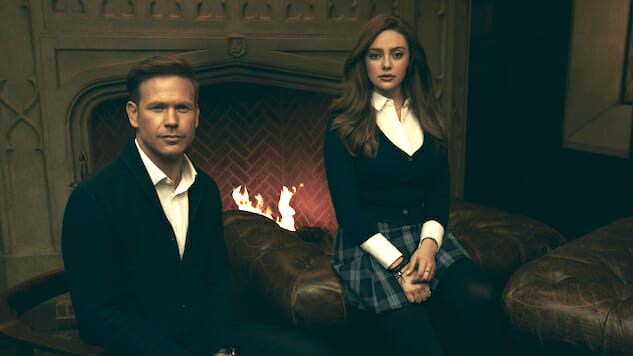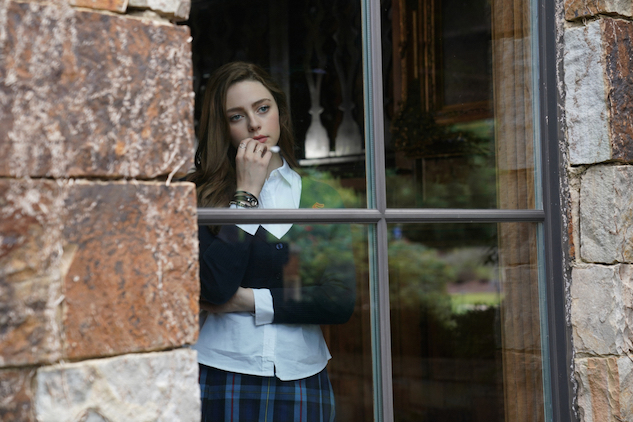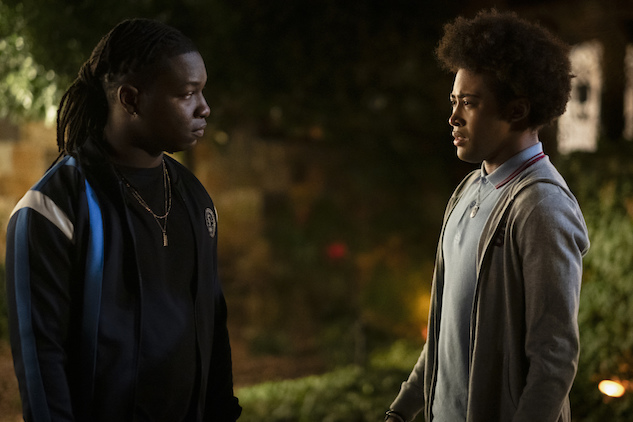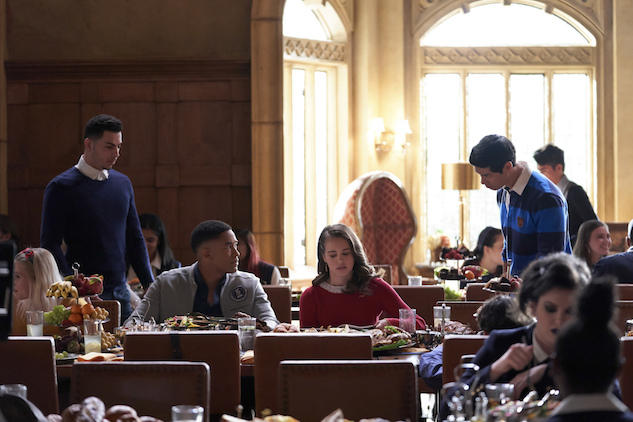5 Reasons You Should Be Watching Legacies
Photos Courtesy of The CW
October is, just objectively, the best month of the year. Exhibit A: Golden autumn leaves. Exhibit B: All things apple. Exhibit C: This gif. Exhibit D: Witches. Like, it’s just science.
Around these parts, though, the best best thing about October is, of course, the television. Yes, I’m talking spooky, kooky Halloween specials—love a good Halloween special—but also I’m talking fall premieres. Specifically, I’m talking The CW’s fall premieres, which have been landing in mid-October (later than most other broadcast networks) since at least the first season of Arrow.
This fall, the teen-skewing network’s biggest draws are, arguably, the series debuts of Batwoman (October 6th) and Nancy Drew (October 9th), and the final season bows of Arrow (October 15th) and Supernatural (October 10th). But while I’m professionally interested in seeing how all those premieres play out, the CW joint I’m most personally invested in getting back on my screen (also October 10th!) is Julie Plec’s supernatural boarding school double-spin-off teen drama series, Legacies.
Friends—you should be watching Legacies. I know there’s a lot of television out there, but really and truly, if you like television that likes being television (more on that in a minute), Legacies is absolutely worth tuning in to. Why? Well, let me just count the reasons:
1. You don’t have to do any television homework to join the fun.
Yes, TECHNICALLY Legacies is a hybrid spin-off of two different long-running Julie Plec series, The Vampire Diaries (eight seasons) and The Originals (five), and sure, technically it was in those series that the mythology driving the character arcs/motivations of Legacies’ most central leads, Hope Mikaelson (Danielle Rose Russell) and Alaric Saltzman (Matthew Davis), was developed. After spending a cumulative thirteen seasons not just telling stories on television, but telling stories on television from this specific world, Plec’s ability to set efficient narrative groundwork under fast-moving vampire feet is nothing if not masterful. Genuinely, aside from a few single-episode cameos of side characters from Hope and Alaric’s TVD/Originals past, the only thing you need to watch to make sense of Legacies is this official promo for the first season:
…and honestly, most of that soliloquy, plus much more, is folded into the cold open of the series premiere, “This is the Part Where You Run,” which uses new lead Landon Kirby (Aria Shahghasemi) as audience avatar as he gets introduced to this particular supernatural world for the first time.
2. Two words: Julie. Plec.
That said, if you are familiar with Legacies’ double, er, legacy, you’ll get a kick out of how precisely Plec has taken her signature whip-fast storytelling and fitted it to a breezier, more “teen” setting, and how deftly she manages to weave in both key characters and core emotional beats from both her previous series.
The most obvious example of all of this is Matthew Davis’ Alaric Saltzman, who became such a fan favorite during his time as vengeful-vampire-hunter-turned-loyal-teen-vampire guardian-turned-rogue-vampire’s-best-friend on The Vampire Diaries that not only did Plec resurrect him from the (very truly) dead to keep Damon Salvatore (Ian Somerhalder) on the straight and narrow, but she then brought him on as co-lead of this series to do the same for every supernatural teen in the contiguous United States. Now, as both father to a pair of Gemini twin witches (Kaylee Bryant and Jenny Boyd) and mentor/father-figure to Hope, the teen witch-vampire-werewolf tribrid with a hero complex, Alaric gets to flex all the emotional muscles TVD fans know and love. Plus, as the Salvatore School’s headmaster, he also gets to take charge of the dramatic supernatural research and heroic (and/or chaotic) supernatural missions that are key to a Plec series’ fast-paced success. Beyond all of that, though, in positioning him as the central human adult foil to a whole pile of supernatural teen protagonists, Plec has also found a way to let him be funny, bringing a uniquely fun dynamic to the fast-moving monster drama of the TVD universe that hasn’t always gotten such pride of place.
In other words: Julie Plec, still running wild supernatural stories turned up way past 11.
3. Three words: Supernatural. Boarding. School.
One more time, in case that didn’t sink it: Supernatural. Boarding. School.
I really shouldn’t have to elaborate on this, but Legacies is set at the Salvatore Boarding School for the Young and Gifted, which is the school for young witches, werewolves, vampires, and Hope that was funded by Hope’s (dead) dad and is located at/on the Salvatore family’s Virginia estate, just outside Mystic Falls. All the moody opulence of Damon and Stefan’s TVD homebase, all the zingy, angsty tropes of great Teen TV.
More than just being a fun setting, though, the Salvatore School gives Legacies a chance to sprawl out and complicate the consequences of being a teenager consigned to eternity as part of the supernatural world. These consequences are still very real and very serious in Legacies, but while The Vampire Diaries mined dramatic tension from supernatural teens (or at least vampires who looked superficially like teens) living in dangerous proximity to human teens, its kid sibling series looks inside for its tension. The teens at the story’s core need, first and foremost, to find a way to come to terms with their own inhumanity, and what it means to be good as they define it. And honestly, after so many years of TVD stories focused on the former, spending time with a bunch of super compelling, super different supernatural kids working through the latter is just a treat.
4. A diverse cast and diverse stories
This leads directly into a key update to the TVD legacy: With such a sprawling cast of teen characters brought to the Salvatore School from all walks of life and corners of the country, Legacies gets to improve on one of the original series’ greatest weaknesses: A lack of diversity. While both Alaric and the three central female characters of Legacies—all carried over from the previous series—are still white, the characters that round out the rest of the new series’ core cast are not. On the adult side, Alaric is joined by faculty members Dorian Williams (Demetrius Bridges) and Emma Tig (Karen David), while on the teen side, Hope, Josie and Lizzie are joined by softie vampire MG (Quincy Fouse), activist vampire Kaleb (Chris Lee), reluctant alpha werewolf Rafael (Peyton “Alex” Smith), ex-alpha werewolf Jed (Ben Levin), bad girl with Penelope (Lulu Antariksa), and the audience avatar/mystery box supernatural mentioned above, Landon Kirby (Aria Shahghasemi). Nor is racial diversity the only benchmark hit with this large cast. In terms of queer representation, Josie is bi, with Penelope her ex/possible future girlfriend; in terms of class representation, Rafael and Landon are foster brothers who both have dark histories with the system.
Importantly, none of these measures of diversity are included just for show. Each character’s identity and background are as key to who they are within the heightened emotional context of the boarding school as their individual supernatural abilities. Kaleb’s experience as a young black man (and vampire) is markedly different from MG’s, which is markedly different from Dorian’s (who, to be fair, is also not a vampire). Josie and Penelope’s relationship is informed by their strengths (and weaknesses) as witches, and further informs how they each approach solving problems both social and magical. Landon and Rafael’s history, as thrown away kids whose only shelter was each other, drives every decision they make. That diverse identities should inform characters in these ways isn’t a surprise; that Legacies is embracing them all now after so many seasons of its parent series falling short is, if not surprising, then at least worth taking note of.
5. Finally: Legacies totally knows it’s a TV show.
This seems self-evident, but as pop culture critic Grace Robertson so sharply observed earlier this year in her essay “Let TV Be TV” (like, literally; the heading above is a direct quote), the best trick Legacies pulls isn’t even a trick. It’s just being good at being entertaining, episodic television.
Only another week and a half to go until the cultural event of the year, season two of Legacies.
— Grace (@GemOfAmara) September 30, 2019
In an era where a TV show can be anything from thirteen thirty-minute episodes (pick literally any prestige comedy) to dozens upon dozens of bite-sized Facebook posts (SKAM Austin) to an 18-hour art film (Twin Peaks: The Return), defining just what counts as television is practically a professional sport. Well, it’s a sport Legacies isn’t interested in playing. With both its new-to-the-TVD-verse Monster of the Week mode of storytelling and the Salvatore School as its comfortable, “fixed point” setting, Plec is even better at framing episodic stories than she was in her already rollicking previous series. In a television landscape so full of cinematic innovation, the freedom this old school “status quo” television model gives Legacies is, as Robertson notes, a huge relief.
So, yes: Legacies knows it’s a TV show, and it knows it’s a fun one. With the short first season currently streaming on Netflix, there is literally no better time to jump on the Legacies bandwagon than now. And I know it’s one I can’t wait to have back in my weekly rotation. All hail October.
Legacies Season Two premieres Thursday, October 10th on The CW.
Alexis Gunderson is a TV critic and audiobibliophile. She can be found @AlexisKG.








































